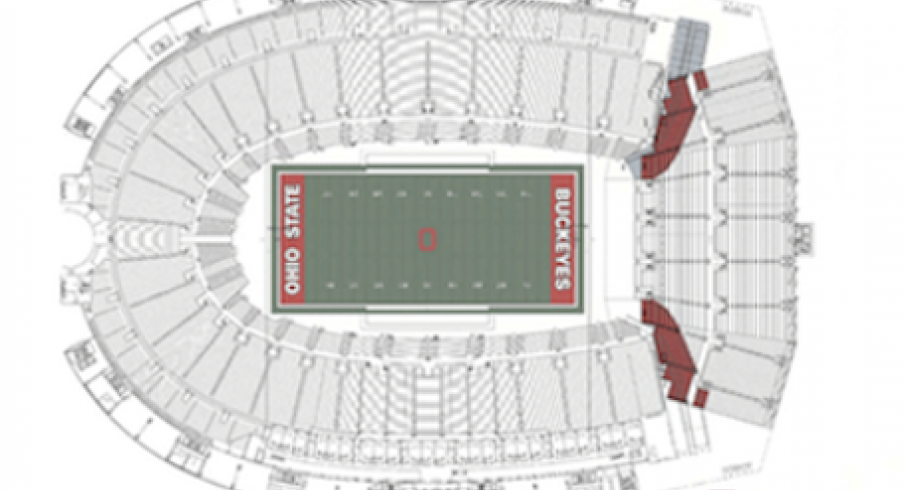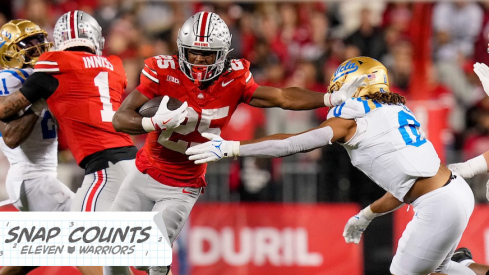There are several constants in present-day intercollegiate athletics: the hypocrisy of the NCAA and a growing arms race between college football programs.
Death. Taxes. New turf fields.
Ohio State has among the best facilities in all of college football. Or football period, NFL included. But that hasn’t stopped the Buckeyes from making several upgrades since the turn of the century.
Just seven years after an extensive overhaul of the Woody Hayes Athletic Center, one of the sport’s Taj Mahals is getting another facelift – of $2.5 million. That’s some strong botox.
Dating to a 2001 renovation of Ohio Stadium, Ohio State has spent nearly $250 million on upgrades to football facilities. The latest projects include an expansion of south stands, permanent lights, a new locker room at the WHAC, the installation of new FieldTurf at Ohio Stadium and two practice fields and maintenance on concrete inside the stadium.
It’s all being done in the name of staying elite. Urban Meyer wants the best players and understands that securing them means offering the top facilities.
“A lot of what you see in some places is plainly addressing deferred maintenance,” Ohio State athletic director Gene Smith told Eleven Warriors. “Typically when you deal with deferred maintenance you also make improvements that help current athletes and help in recruiting. Athletics is no different than engineering or medicine, to attract the best and retain the best, you have to have the resources, which include facilities.”
Minnesota head coach Jerry Kill experienced the horrors of losing a recruit due to inadequate practice quarters. Despite a sparkling five-year-old $300 million stadium with glitzy accommodations, the Gophers have arguably the worst practice facility in the Big Ten. The Gibson-Nagurski Football Complex was built in 1985 and is, not surprisingly, outdated.
The 12,000-squre foot facility doesn’t feature the bells and whistles seen at Ohio State, Alabama and USC, whose buildings are three times the size of Minnesota’s. The Gophers are not keeping up with the Joneses.
Minnesota’s antiquated $5 million facility doesn’t even have a ceiling height conducive for punting and kicking. In the uber-competitive world of recruiting, falling behind rival schools can be a death knell.
The Vikings are pumping $4.5 million into TCF Bank Stadium during their two-year stay. But college practice facilities have become more valuable than stadiums, where teams only spend three-plus hours out of the week.
Hockey legend Lou Nanne, a Minnesota grad, is chairing a $190 million fundraising drive for improvements of university athletic facilities. In March, the Star-Tribune reported Minnesota would break ground on a new $ 70 million indoor football complex in December. But Nanne and athletic director Norwood Teague refuted the report.
Nanne said the price tag is much smaller and there’s no timetable for when construction might begin. The university is still in the fundraising stage, adding that a football facility is at the top of the list.
Among the dozens of current projects taking place across the Big Ten landscape is Michigan’s $9 million overhaul of Schembechler Hall, which includes 14,000 square feet of team and office space and a state of the art museum dedicated to Michigan football; Iowa’s $55 million 76,000-square foot football operations center; Northwestern’s lakefront facility on the shores of Lake Michigan, which is estimated to cost more than $220 million; and skyrocketing head coach and assistant coaches contracts.
Since 2001, Big Ten schools have spent more than $1.5 billion on new or upgraded football venues, ranging from a new stadium to new practice facilities to fancy scoreboards. All 14 schools, including Maryland and Rutgers, have had extensive stadium renovations. Maryland and Rutgers enter the Big Ten after stadium upgrades totaling more than $160 million. Updating facilities has proven to be a recession-proof industry.
Ohio Stadium was built in 1922 at a cost of $1.34 million. During its first 80 years of existence, the Horseshoe was relatively untouched. But that changed with a $194 million renovation from 2000 to 2001.
The track was removed, which allowed the field to be lowered and seating closer to the action. Suites, a new press box, permanent south stands and a state-of-the-art video board were among the biggest changes. The seating capacity rose more than 10,000 to 101,568.
For the 2014 season, it will be 104,851, thanks to an additional 2,522 seats in south stands.
According to Sports Business Journal, from 1995-2005, spending on athletic facilities across the country topped $15 billion. Decisions are made with fan experience in mind. But every choice major college football programs make is with a recruiting edge in mind.
“It’s an arms race out there in recruiting,” said Iowa head coach Kirk Ferentz, who admitted Ohio State “probably” has the best facilities in the Big Ten. “For the long-term success of our programs, our facilities needed to be addressed. These have been adequate and they’ve worked and we’ve won games with these facilities, but with the pace of recruiting, like it or not, it’s important to recruits. If you can’t recruit, you can’t survive.”
Michigan had that in mind when it constructed the 104,000-square foot $26 million Al Glick Fieldhouse in 2009. Combined with Schembechler Hall, the Wolverines have team meeting rooms that also can be found in the Waldorf-Astoria.
Players from major programs experience better daily conditions than middle-class families. There are swanky locker rooms, couches, lounge chairs, countless flat screen HDTVs, pool tables, video games, basketball courts and swimming pools.
“There’s an arms race that continues to grow,” Michigan head coach Brady Hoke said. “We’re doing fine. You’re not going to find a better [facility].”
Now, more than ever, there are consistent sources of income for athletic departments, with TV contracts in the tens of millions of dollars, deep-pocketed boosters never shying away to help out Old State U and a spike in ticket prices. Ohio State, Michigan and Wisconsin have done renovations to their stadiums, all built in the 1920s, for more than $100 million apiece.
The bulk of those projects were funded by sales of suites, club seats and other private donations. Naming rights is another lucrative avenue for universities. Illinois’ recently renamed Assembly Hall, now the State Farm Center, is part of a $60 million deal with the insurance giant that lasts 30 years.
In 2013, Big Ten members received a $25.7 million payout from the conference. $19 million was TV revenue, with more than $6 million coming from the Big Ten Network. Conference schools have benefitted since the network’s launch in 2007, as its revenue has increased 57 percent.
“The Big Ten Network is the best thing since canned soup,” Indiana athletic director Fred Glass told ESPN. “That’s how Rip Van Winkle is waking up here in Indiana. It’s not hyperbole to say that every one of our 24 sports have benefited from facility improvements which were driven by Big Ten Network revenues.”
Ohio State earns an additional $11 million annually from a media rights deal with IMG.
“I spend about 65 percent of my time fund raising and in revenue generation,” Smith said.
The proof of an arms race is at every turn, whether it’s waterfalls in Tuscaloosa, Arizona’s $378 million stadium expansion or LSU’s Tiger Stadium project. But the $50 million and hundreds of millions spent by Indiana and Northwestern, respectively, is all the evidence one needs.
For the Wildcats, it’s such a significant undertaking that it’s been titled “Game Changer” by the university.
“We’ve seen great momentum with that in the recruiting process,” Northwestern Coach Pat Fitzgerald said last fall when the plans were announced. “I don’t know how many teleconferences I’ve been on with our architect team. It’s kind of cool for me.
“I’ve only bought spec homes so I don’t really care what the urinal looks like, you know what I mean? I guess it’s important for recruiting.”


